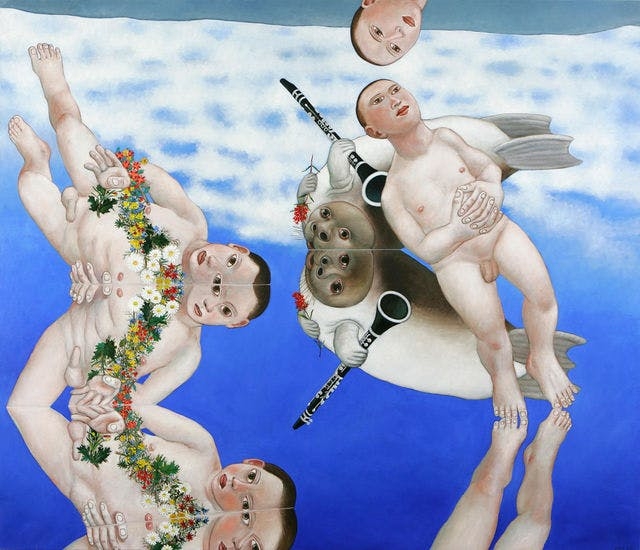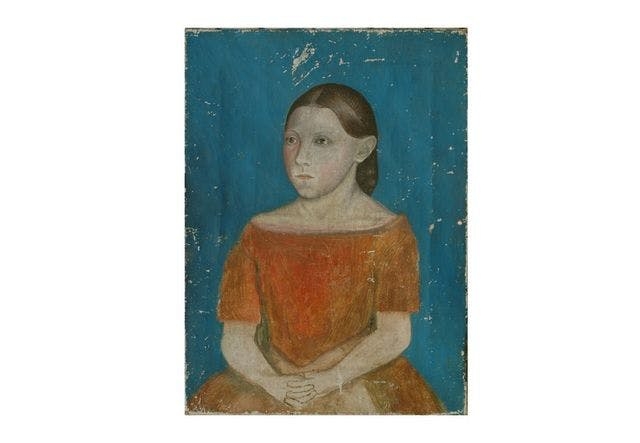Saga - Narrative art
22.5.2015 — 6.9.2015

The exhibition includes selected works of a number of Icelandic contemporary artists, as well as several foreign ones, that reflect the narrative part of Icelandic visual art. The exhibition was at Kunsthalle Recklinghausen in 2014 and will be in KUMU, The Museum of Contemporary Art in Tallinn, Estonia, this autumn. The works of the exhibition are selected by the Director of the National Gallery of Iceland, Halldór Björn Runólfsson, and a German curator, Norbert Weber. The choices reflect the vision on Icelandic culture that the visitor's keen eye can provide. The exhibition sheds light on the culture of a nation, from the depth of the mind to political conflict.
Part of the exhibition includes recent interviews with the contributing artists. The exhibition is accompanied by a strong educational program intended for Icelandic and foreign visitors.
The works exhibited are by: Björk, Dieter Roth, Erró, Gabríela Friðriksdóttir, Helgi Þorgils Friðjónsson, Hrafnkell Sigurðsson, Hulda Hákon, Jóhannes S. Kjarval, Kristleifur Björnsson, Ólafur Elíasson, Ólöf Nordal, Ósk Vilhjálmsdóttir & Anna Hallin, Ragnar Kjartansson, Sigurður Guðmundsson, Steingrímur Eyfjörð and Þórður Ben Sveinsson.
Curators: Norbert Weber and Halldór Björn Runólfsson
The exhibition is the contribution of the National Gallery of Iceland to the Reykjavik Arts Festival.
From the ancient sagas to the novels of Nobel laureate Halldór Laxness, literature is probably Iceland's most important contribution to world civilization. The art of storytelling is highly regarded in Iceland, as witness the fact that more than a thousand titles are published each year, in a population of under 330,000. In view of this, it is natural to turn the attention to narrative art when an exhibition of Icelandic art is organized.
On close scrutiny, many of the exhibits appear to possess a significant dramatic quality on a par with that found in the country's literature. The unpredictable nature of the island, and the consequent living conditions of its habitants, have inspired many Icelandic artists to deal with extremely poignant themes. The structure of the exhibition is based on plot and the concept of a dramatic composition: it opens with works representing a stage; a remake of the panoramic view of Þingvellir, Tal von Thingvalla, a painting by Johann Heinrich Hasselhorst from 1862 and the first painting made of Þingvellir, and the diverse scenes of the place by Jóhannes Sveinsson Kjarval. The works of the latter segue into introductory themes of characters and rhapsodic cycles constituting a certain kind of narrative prologue. Contemporary art comprises the majority of the exhibition, beginning with the works of the SÚM group and their circle and leading to the present with the life-size photos of Ólöf Nordal and interactive music apps by singer/composer Björk. The epilogue is in the form of a series by Ólafur Elíasson, a work which visually addresses the financial crisis recently experienced by Icelanders. Throughout this survey, critical or fantastic accounts of contemporary and historically relevant events and legends, amalgamated with factual or imaginary scenes, strike us with stunning candour and enticingly cryptic depiction. The mystery behind Erró's puzzling juxtapositions, Sigurður Guðmundsson's absurd photographic situations, Gabríela Friðriksdóttir's crepuscular installation, Hrafnkell Sigurðsson's fish-processing warriors, Ragnar Kjartansson's youthful Rock reiteration, Hulda Hákon's financial demons, Steingrímur Eyfjörð's tragic yet hilarious hill surrogates, Helgi Þorgils Friðjónsson's transcendental figures, Þórður Ben Sveinsson's science- fiction paraphrases of the hanging gardens of ancient civilizations, and Kristleifur Björnsson's haunting portraits, is based on riddling stories which demand to be decoded by a curious public. The same goes for the Carroll type riddle in Anna Hallin's and Ósk Vilhjálmsdóttir's critical video installation. Although they seem cloudless, the sagas behind Icelandic narrative art are neither simple nor easy.
Halldór Björn Runólfsson, Museum director.



